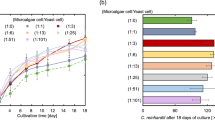Abstract
Supplementation with CaCl2·2H2O (50 mg l−1) or CuSO4·5H2O (10 mg l−1) improved mannitol production by Candida magnoliae by 14.5 and 18.6% (25 and 32 g/L), respectively. When used in combination, they acted synergistically: Ca2+ decreased the intracellular concentration of mannitol 30%, whereas Cu2+ increased the intracellular activity of mannitol dehydrogenase 1.6-times more than control. Ca2+ probably works by altering the permeability of cells to mannitol, whereas, Cu2+ increases the activity of an enzyme responsible for mannitol biosynthesis.

Similar content being viewed by others
References
Furia TE (1972). In: Bergmeyer H. U. (ed) Handbook of Food Additives, 2nd edn, Cleveland:CRC Press, pp. 431–455
Kim TB, Oh DK (2003) Xylitol production by Candida tropicalis in a chemically defined medium. Biotechnol Lett 25:2085–2088
Lee JK, Ha SJ, Kim SY, Oh DK (2000) Increased erythritol production in Torula sp. By Mn2+ and Cu2+. Biotechnol Lett 22:983–986
Lee JK, Koo BS, Kim SY (2002) Fumarate-mediated inhibition of erythrose reductase, a key enzyme for erythritol production by Torula corallina. Appl Environ Microbiol 68:4534–4538
Lee JK, Koo BS, Kim SY, Hyun HH (2003) Purification and characterization of a novel mannitol dehydrogenase from a newly isolated strain of Candida magnoliae. Appl Environ Microbiol 69:4438–4447
Lewis DH, Smith D C (1967) Sugar alcohols (polyols) in fungi and green plants. I. Distribution, physiology and metabolism. New Phytol 66: 143–184
Makkee M, Kieboom APG, Bekkum HV (1985) Production methods of D-mannitol. Starch 37:136–141
Pharr DM, Stoop JMH, Studer-Feusi ME, Wiliamson JD, Massel MO, Cokling MA. z1995) In: Madore, M. A. and Lucas, W. J. (eds) Current Topics in Plant Physiol American Society of Plant Physiologists, Vol. 13 Rockville, MD, , p. 180
Smirnoff N, Cumbes QJ (1989) Hydroxyl radical scavenging activity of compatible solutes. Phytochemistry 28:1057
Song KH, Lee JK, Song JY, Hong SG, Baek H, Kim SY, Hyun HH (2002) Production of Mannitol by a novel strain of Candida magnoliae HH-01. Biotech Lett 24:9–12
Wisselink HW, Weusthuis RA, Eggink G., Hugenholtz J, Grobben GJ (1990) annitol production by lactic acid bacteria: a review. International Dairy Journal 12:151–161
Wong B, Perfect JR, Beggs S, Wright KA (1990) roduction of the hexitol D-mannitol by the pathogenic fungus Cryptococcus neoformans in vitro and in rabbits with experimental meningitis. Infect Immun 58:1664–1670
Yun JW, Kim DH (1998) comparative study of mannitol production by two lactic acid bacteria. J Ferment Bioeng 85:203–208
Zhao XJ, Sucoff E, Stadelmann EJ (1987) l3+ and Ca2+ Alteration of Membrane Permeability of Quercus rubra Root Cortex Cells. Plant Physiol 83:159–162
Acknowledgment
This paper was supported by Konkuk University in 2006.
Author information
Authors and Affiliations
Corresponding author
Rights and permissions
About this article
Cite this article
Lee, JK., Oh, DK., Song, HY. et al. Ca2+ and Cu2+ supplementation increases mannitol production by Candida magnoliae . Biotechnol Lett 29, 291–294 (2007). https://doi.org/10.1007/s10529-006-9230-4
Received:
Revised:
Accepted:
Published:
Issue Date:
DOI: https://doi.org/10.1007/s10529-006-9230-4




